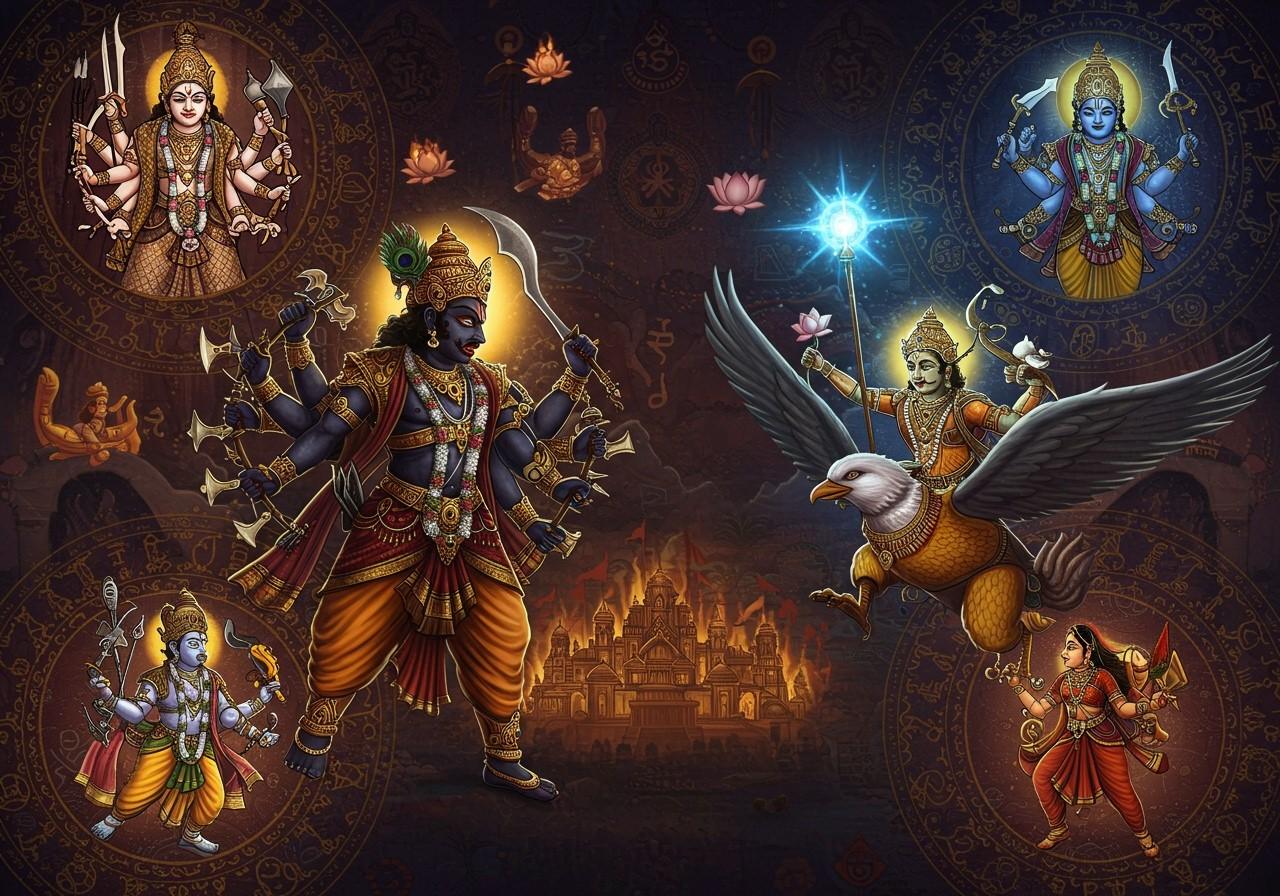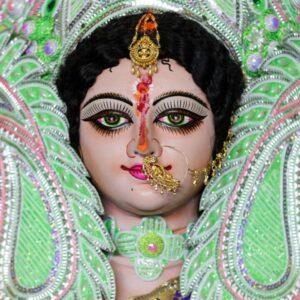
Narakasura, a prominent figure in Hindu mythology, holds particular significance during Deepavali (Diwali). This blog delves into the diverse interpretations of Narakasura across Tamil, Telugu, and Hindi cultures, providing insights into regional mythologies and their cultural importance. His defeat by Lord Krishna is celebrated as Naraka Chaturdashi or Choti Diwali, symbolizing the triumph of good over evil.
Narakasura in Tamil Culture
Tamil Interpretation of Narakasura
- Origins: Narakasura’s story in Tamil mythology originates from ancient texts and oral traditions, passed down through generations and embodying deep cultural values. His tale intertwines with local narratives and beliefs, enriching the tapestry of Tamil folklore.
- Deepavali Significance: In Tamil Nadu, Deepavali is known as Naraka Chaturdashi, commemorating Narakasura’s defeat by Lord Krishna and Satyabhama. This victory symbolizes the triumph of light over darkness and good over evil, a core theme of Deepavali celebrations.
- Literature: Tamil classical texts and regional epics frequently mention Narakasura, highlighting the moral and philosophical lessons derived from his defeat and the subsequent restoration of righteousness.
- Rituals: Lighting lamps, bursting fireworks, and cleaning homes are customary practices during Naraka Chaturdashi in Tamil Nadu. These rituals symbolize purification, renewal, and the welcoming of prosperity.
- Temple Art: Temples like the Meenakshi Amman Temple depict Narakasura in their iconography, symbolizing the triumph of good over evil and reinforcing the cultural significance of his story.
- Performing Arts: Bharatanatyam and folk theatre often incorporate stories of Narakasura, bringing his tale to life through expressive dance and dramatic performances, engaging audiences in cultural storytelling.
- Cinema Influence: Tamil cinema has played a role in shaping modern perceptions of Narakasura, with notable movies and actors portraying his story and reflecting contemporary cultural narratives.
Narakasura in Telugu Culture
Telugu Interpretation of Narakasura
- Origins: Telugu literature and folklore offer a rich narrative of Narakasura, reflecting the region’s vibrant mythological heritage and its unique perspective on the asura king.
- Deepavali Significance: In Andhra Pradesh and Telangana, Naraka Chaturdashi is marked by special festivities, family gatherings, and joyous celebrations, signifying the victory of good over evil and the renewal of hope.
- Literature: Works by renowned Telugu poets like Nannaya, Tikkana, and Yerrapragada feature Narakasura’s tales, exploring his character, motivations, and the profound lessons learned from his downfall.
- Rituals: Symbolic house cleaning and oil baths are integral parts of the Naraka Chaturdashi celebrations in Telugu culture, signifying purification, renewal, and the casting away of negativity.
- Temple Art: Temples such as the Tirupati Venkateswara Temple showcase Narakasura in their art, reminding devotees of the moral victory over evil and the importance of righteousness.
- Performing Arts: Kuchipudi dance and regional theatre frequently portray Narakasura’s story, enriching Telugu cultural expression and preserving the narrative through generations.
- Cinema Influence: Telugu films and cultural icons have influenced contemporary views of Narakasura, bringing his myth to the forefront and engaging new generations with the ancient tale.
Narakasura in Hindi Culture
Hindi Interpretation of Narakasura
- Origins: Hindi mythology traces Narakasura’s story through significant texts like the Ramayana and Mahabharata, establishing his presence within the broader Hindu mythological framework.
- Deepavali Significance: Naraka Chaturdashi is a crucial part of Deepavali in North India, symbolizing the victory of good over evil and encouraging introspection, self-improvement, and spiritual growth.
- Literature: Medieval texts and modern retellings in Hindi literature feature Narakasura, offering diverse perspectives on his role in Hindu mythology and his impact on cultural narratives.
- Rituals: Lighting diyas and community feasts are traditional practices during Naraka Chaturdashi in North India, fostering community spirit, cultural continuity, and shared celebration.
- Temple Art: Temples like the Kashi Vishwanath Temple depict Narakasura in sculptures and artwork, serving as a reminder of moral principles, spiritual teachings, and the consequences of evil actions.
- Performing Arts: Kathak dance and regional folk dramas often include Narakasura’s tale, enriching the cultural tapestry with vibrant storytelling, music, and expressive movement.
- Cinema Influence: Bollywood has played a significant role in shaping popular perceptions of Narakasura, with films featuring his story helping to keep the myth alive in contemporary culture.
How Poojn.in Helps You Honor Regional Traditions
Poojn.in offers a wide selection of authentic ritual items that cater to the diverse cultural traditions surrounding Narakasura across India. We recognize that different regions have specific customs and require unique items for this important observance. Whether you’re seeking traditional oil lamps, pure coconuts, or high-quality incense, Poojn.in provides a convenient platform to honor your regional customs.
Poojn.in understands the importance of using specific items and following unique customs in different regions. We aim to provide a comprehensive selection to meet the diverse needs of our customers across India. You can find various products like sandalwood incense sticks, brass Laddu Gopal murtis, and more, to help you observe the traditions with authenticity.
Visit poojn.in to explore our complete range of ritual items for Narakasura traditions. All products are quality-assured and carefully packaged to preserve their purity and sanctity.
Conclusion
Exploring Narakasura’s story across Tamil, Telugu, and Hindi cultures reveals the rich tapestry of India’s mythological heritage. Each region’s unique perspective enhances our understanding of this significant figure and the timeless triumph of good over evil. By appreciating these varied interpretations, we connect with our heritage and embrace the enduring power of light over darkness, as celebrated during Deepavali.

